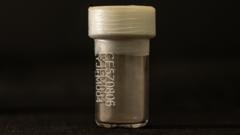The specks of moon dust, which have been described as "rarer than gold," secured their arrival in a high-security facility in Milton Keynes, led by UK scientist Professor Mahesh Anand, who is now set to explore their cosmic secrets.
The samples, collected by China's Chang'e 5 mission in 2020, mark a significant moment in lunar research. Officially on loan to the UK, these tiny grains are poised to help answer longstanding questions about the formation of the Moon and Earth's early history. “These samples offer a rare glimpse into our celestial neighbor's past,” says Prof Anand.
A history-making ceremony in Beijing saw Prof Anand receive these valuable specimens, underscoring China’s growing role in space exploration and collaboration. He traveled back with the samples tightly secured in his hand luggage, establishing strict protocols upon their arrival in his lab to avoid contamination.
With about 60mg in total, the dust resides within specially designed containers, and Anand emphasizes that “the small is mighty” in terms of scientific inquiry. One of his technicians, Kay Knight, prepares to be the first to work on the samples — a task imbued with both excitement and anxiety due to their scarcity.
A unique setup of machinery awaits, designed to analyze the lunar dust by extracting gases and elements critical for understanding the Moon's geological history. The research team has one year to conduct their analysis, which they anticipate may lead to the destruction of some of the samples due to the nature of the investigations.
Prof Anand expresses hope for a sustained collaboration with China, aiming for further exploration and discovery in lunar research. “I believe this could usher in a new era for international scientific endeavors,” he added.
The Chang'e 5 mission not only elevates China in the realm of space exploration but also presents unprecedented opportunities for researchers worldwide as they prepare for future missions and further questions about the Moon's hidden depths.
The samples, collected by China's Chang'e 5 mission in 2020, mark a significant moment in lunar research. Officially on loan to the UK, these tiny grains are poised to help answer longstanding questions about the formation of the Moon and Earth's early history. “These samples offer a rare glimpse into our celestial neighbor's past,” says Prof Anand.
A history-making ceremony in Beijing saw Prof Anand receive these valuable specimens, underscoring China’s growing role in space exploration and collaboration. He traveled back with the samples tightly secured in his hand luggage, establishing strict protocols upon their arrival in his lab to avoid contamination.
With about 60mg in total, the dust resides within specially designed containers, and Anand emphasizes that “the small is mighty” in terms of scientific inquiry. One of his technicians, Kay Knight, prepares to be the first to work on the samples — a task imbued with both excitement and anxiety due to their scarcity.
A unique setup of machinery awaits, designed to analyze the lunar dust by extracting gases and elements critical for understanding the Moon's geological history. The research team has one year to conduct their analysis, which they anticipate may lead to the destruction of some of the samples due to the nature of the investigations.
Prof Anand expresses hope for a sustained collaboration with China, aiming for further exploration and discovery in lunar research. “I believe this could usher in a new era for international scientific endeavors,” he added.
The Chang'e 5 mission not only elevates China in the realm of space exploration but also presents unprecedented opportunities for researchers worldwide as they prepare for future missions and further questions about the Moon's hidden depths.


















